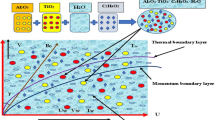Abstract
The present study consists of a pool boiling model modified for nanofluids. The effect of particle size, surface roughness were considered in this work. Nucleation site density ratio was introduced and a correlation was derived based on literature experimental data. Moreover, heat flux partitioning model was employed to evaluate proposed model for boiling heat transfer. The validity was assessed by comparing the results with experimental data. Nucleation site density ratio can predict heat transfer enhancement of nanofluids.




Similar content being viewed by others
References
Das SK, Putra N, Roetzel W (2003) Pool boiling characteristics of nanofluids. Int J Heat Mass Transf 46:851–862
Ahmed O, Hamed MS (2010) The effect of experimental techniques on the pool boiling of nanofluids, Proceedings of the 7th Int. Conference on Multiphase Flow (ICMF),Tampa, FL, USA
Ahmed O, Hamed MS (2012) Experimental investigation of the effect of particle deposition on pool boiling. Int J Heat Mass Transf 55:3423–3436
Wen Dongsheng, Corr Michael, Hua Xiao, Lin Guiping (2011) Boiling heat transfer of nanofluids: The effect of heating surface modification. Int J Therm Sci 50:480–485
Gerardi C (2009) Investigation of the pool boiling heat transfer enhancement of nano-engineered fluids by means of high-speed infrared thermography, PhD thesis Massachusetts Institute of Technology Cambridge
Jackson J, Bryan J (2007) Investigation into the pool boiling characteristics of gold nanofluids, University of Missouri-Columbia
Harish G, Emlin V, Sajith V (2011) Effect of surface particle interactions during pool boiling of nanofluids. Int J Therm Sci 50:2318–2327
Wen D, Ding Y (2005) Experimental investigation into the pool boiling heat transfer of aqueous based gama-alumina nanofluids. J Nanopart Res 7:265–274
Gerardi C, Buongiorno J (2011) Infrared thermometry study of nanofluid pool boiling phenomena. Nanoscale Res Lett 6:232
Bang In C, Chang SH (2005) Boiling heat transfer performance and phenomena of Al2O3-water nano-fluids from a plain surface in a pool. Int J Heat Mass Transf 48:2407–2419
Narayan GP, Anoop KB, Das SK (2007) Mechanism of enhancement/deterioration of boiling heat transfer using stable nanoparticle suspensions over vertical tubes. J Appl Phys 102(7):074317
Kole M, Dey TK (2012) Investigations on the pool boiling heat transfer and critical heat flux of ZnO-ethylene glycol nanofluids. Appl Therm Eng 37:112–119
St. White B, Albert JS, Pipe KP (2010) Effects of nanoparticle layering on nanofluid and base fluid pool boiling heat transfer from a horizontal surface under atmospheric pressure. J Appl Phys 107:114302
Gorefno D (1993) Pool boiling, VDI Heat Atlas. VDI Verlag, Dsseldorf
Maiga S, Palm SJ, Nguyen CT, Roy G, Galanis N (2005) Heat transfer enhancement by using nanofluids in forced convection flows. Int J Heat Fluid Flow 26:53046
Timofeeva E, Gavrilov A, McCloskey J, Tolmachev Y (2007) Thermal conductivity and particle agglomeration in alumina nanofluids, experiment and theory. Phys Rev 76:061203
Kurul N, Podowski MZ, On the modeling of multidimensional effects in boiling channels, Minneapolis, Minnesota, USA, Proceedings of the 27th National Heat Transfer Conference, July 1991
Cole R (1960) A photographic study of pool boiling in the region of the critical heat flux. AIChE J 6:533542
Unal HC (1976) Maximum bubble diameter, maximum bubble growth time and bubble growth rate during subcooled nucleate flow boiling of water up to 17.7 MNm2. Int J Heat Mass Transf 19:643–649
Lemmert M, Chawla JM (1977) Influence of flow velocity on surface boiling heat transfer coefficient. Heat Transfer and Boiling. In: E. Hahne, U. Grigull (eds), Academic Press
Lavieville J, Quemerais E, Mimouni S, Boucker M, Mechitoua N (2005) NEPTUNE CFD V1.0 theory manual, EDF
Yao C, Morel W (2004) Volumetric interfacial area prediction in upward bubbly two-phase flow. Int J Heat Mass Transf 27:307–328
Menter FR (1994) Two-equation eddy-viscosity turbulence models for engineering applications. AIAA J 32(8):1598–1605
Acknowledgments
The author also would like to thank Iran National Science Foundation (INSF) for their financial support of the project.
Author information
Authors and Affiliations
Corresponding author
Rights and permissions
About this article
Cite this article
Niknam, P.H., Haghighi, M., Kasiri, N. et al. Numerical study of low concentration nanofluids pool boiling, investigating of boiling parameters introducing nucleation site density ratio. Heat Mass Transfer 51, 601–609 (2015). https://doi.org/10.1007/s00231-014-1433-y
Received:
Accepted:
Published:
Issue Date:
DOI: https://doi.org/10.1007/s00231-014-1433-y




